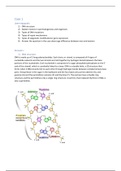Case 1
Learning goals:
1) DNA structure
2) Explain meiosis in spermatogenesis and oogenesis
3) Types of DNA mutations
4) Types of repair mechanisms
5) Types of epigenetic modifications/ gene expression
6) Answer the question in the case about age difference between men and women
Answers:
1) DNA structure
DNA is made up of 2 long polynucleotides. Each chain, or strand, is composed of 4 types of
nucleotide subunits and the two strands are held together by hydrogen bonds between the base
portions of the nucleotides. Each nucleotide is composed of a sugar-phosphate (phosphate on the 5’
end of the strand) which is covalently linked to a base. DNA is a double helix, a 3D structure that
forms when 2 DNA strands link to each other through hydrogen bonds between complementary base
pairs. Deoxyribose is the sugar in the backbone and the four bases are purines adenine (A), and
guanine (G) and the pyrimidines cytosine (C) and thymine (T). The purines have a double ring
structure and the pyrimidines only a single ring structure. Uracil (U), that replaced thymine in RNA, is
also a pyrimidine.
,DNA replication
Leading strand is the 3’ → 5’ direction
Lagging strand 5’ → 3’ direction
Helicase breaks the hydrogen bonds
Single strand binding proteins coat the DNA around the replication fork to prevent breaking down by
nucleases
Primase produces a primer (or multiple in the case of the lagging strand) as a starting point for the
DNA synthesis
DNA polymerase 3 binds to the DNA and synthesises DNA in the 5’ → 3’ direction
DNA polymerase 1 removes the RNA primers and replaces these by DNA
➔ Has also exonuclease function
➔ Can proofread
Ligase glues everything together
Topoisomerase unwinds the DNA and prevents the DNA from supercoiling
Transcription copying out DNA
1) Initiation
• Transcription factors
2) Elongation
• RNA polymerase transcribes the DNA and forms RNA
3) Termination
• Terminators signal that the transcription is complete and pre-RNA is formed.
PreRNA → Mature RNA: introns/exons splicing, poly A-tail and 5’-cap for protection
Splicing is done by snRNPs -> U1, U2, U4, U5 and U6
Translation
mRNA is decoded by ribosomes, they consist out of a large subunit and a small subunit.
A ribosome consists out of an A-site, a P-site and an E-site. The first Met amino acid will always bind
in the P-site, after that a charged tRNA with the right amino acid will come in at the A-site, move to
the P-site and leave via the E-site.
, 2) Spermatogenesis and oogenesis
Crossing over happens in prophase 1 (kind of the same principle as homologous recombination)
Male gametogenesis:
At birth, the testes of the baby boy have not yet progressed beyond mitosis and contain only
immature germ cells. After birth, the gonads become quiescent (relatively inactive) until puberty,
where the gonad matures.
At puberty, the germ cell mitosis continues. The germ cells are now called spermatogonia. A
spermatogonium either continues to undergo mitosis for the rest of the male’s reproductive life, or it
starts the meiosis and becomes a primary spermatocyte.
One primary spermatocyte can create 4 sperm cells. A primary spermatocyte (4n) divides into 2
secondary spermatocytes (2n). Each of these secondary spermatocytes divides into 2 spermatids
(1n), which has 23 chromosomes. The spermatid then matures to become a sperm cell.
, Female gametogenesis:
Oogonia complete mitosis and the DNA duplication stage of the meiosis by the fifth month of fetal
development, resulting in primary oocytes (4n). At birth, each ovary contains about half a million
primary oocytes. Germ cell mitosis ceases and no new germ cells are formed.
In the ovary, meiosis does not resume until puberty. If a primary oocyte develops, it divides into 2
cells, the secondary oocyte and the first polar body, both containing 23 chromosomes. The first polar
body disintegrates. If the oocyte is selected for ovulation, the second meiotic division takes place just
before the egg is released from the ovary. The sister chromatids are separated but now meiosis is
paused again. The final step of meiosis, in which the sister chromatids go to separate cells, does not
happen until the egg is fertilized. If the egg is not fertilized, meiosis never goes to completion and the
oocyte disintegrates. If fertilization by a sperm occurs, the final step of meiosis takes place. Half of
the sister chromatids remain in the fertilized egg (zygote) and the other half is released in the 2nd
polar body, and this one degenerates. Each primary oocyte only gives rise to one egg.




